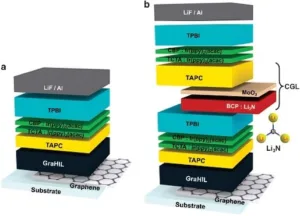A team from Pohang University of Science and Technology (Pohang, South Korea) is developing an OLED that is claimed to be extremely flexible as well as very efficient when compared to current OLED technologies.
The team is headed by Tae-Woo Lee, an Assistant Professor in the Polymer Science Research Group within the Materials Science and Engineering Department. A recent article on the subject of this article and authored by the team appeared in NPG Asia Materials (2016) 8, e303 and can be found on-line here.
The new OLED configuration is based on the use of graphene as a replacement for the conventionally used material, Indium Tin Oxide (ITO) as the anode. Part of the incentive to replace ITO derives from the facts that it has a poor tolerance to external mechanical stress and that its cost has been increasing due to a growing scarcity of indium. Graphene is not only highly transparent but also quite flexible. In addition, the team reports that the graphene does not readily atomize and diffuse into the luminescence layers, as does ITO, which increases the life of the OLED device.
To improve the luminous current efficiency of the device, the team used a configuration in which the OLED is composed of two electro-phosphorescence layers stacked on top of each other. One of the challenges in implementing this approach is the fact that depositing the extra layers that are needed to stack two luminous layers would normally mean the use of high temperature chemical deposition processes. Such a process can damage the existing substrate layer. To overcome this problem, the team included an additional so-called charge generation layer. This layer is applied at a “low” temperature that is compatible with the organic materials. In addition, the charge generation layer also helps to carry and inject charges through the stack.
The figure below and to the left illustrates the layer structure of a conventional OLED device while the figure below and to the right is that of the new device configuration. The terminology used in these figures is defined and explained in the NPG Asia Materials article.
The team explains that, while there are other reports of OLEDs that use graphene anodes, the new OLED stack configuration represents an improvement in efficiency and efficiency roll-off. More specifically, a conventional single stack, graphene-based OLED has an external quantum efficiency of 32.7%. The new OLED configuration has an efficiency as high as 45.2% and 87.3% with a hemispherical lens. More than that, the stacked OLEDs with a graphene anode showed excellent mechanical stability after bending tests of up to 1000 cycles and 6.7% strain.
The team concluded their NPG Asia Materials article by stating that the new OLED configuration and fabrication processes can “provide a significant step towards next generation flexible displays and solid state lighting with graphene anodes.” -Arthur Berman
Pohang University of Science and Technology, Tae-Woo Lee, +82-54-279-2151, [email protected]

